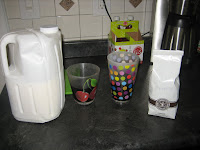Drinking coffee during the pandemic: Arabica, Robusta, or a nice, sultry blend?
In the midst of a global existential crisis, there’s more
time to ponder things you promised yourself you would explore---one day. And as
distractions go, learning about the differences between Arabica and Robusta
coffee is a worthy pursuit.
Arabica versus Robusta—is one better than the other?
There are over 100 species of coffee, but the two main species marketed for consumption are Arabica, (grows in South America, as well as some parts of Africa) and Robusta (grows in Vietnam, Indonesia, and also in some parts of Africa).
What’s the difference?
Arabica and Robusta are different in
many ways, but the short-version answer is that Arabica is a higher quality
coffee than Robusta. Any coffee that is touted as “100% Arabica” is considered
the gold standard by self-described coffee connoisseurs. For the most part,
that’s true---but not entirely. There are some really good Robusta blends out there.
Compared with Arabica’s fruity essence and its high-acidity,
slightly sweet flavor profile, Robusta is bitter and earthy. Robusta has even
been referred to as having a burnt rubber taste (I disagree, but haters gonna
hate). Compared with Robusta coffee, Arabica has 60% more lipids, and almost
twice the concentration of sugar.
And for all of you caffeine lovers, ounce for ounce, Robusta has almost twice the caffeine as Arabica (2.7% to 1.5%).
The difference starts at the green bean level, before any
blending and roasting is done. Arabica beans are generally bigger than Robusta
beans, which are not only smaller, but also rounder and thicker. Despite this size advantage, Arabica beans
are more fragile and harder to grow than Robusta beans, which mature twice as
fast as Arabica beans (2 years versus 4 years). Robusta beans can fend off damage from insects
because of their high level of caffeine and can grow in different altitudes.
Arabica beans tend to grow best in high altitudes with volcanic soil.
Can Robusta get a
little love?
Starbucks brags that all of its coffee is 100% Arabica. There are a lot of very good Arabica blends. We
know that. I mean, even Maxwell House, which has been a largely Robusta-based
brand (with a bit of Arabica mixed in), announced last summer that it would be
transitioning to a 100% Arabica blend.
But Robusta has a place in the pantheon as well. There are
some high-end 100% Robusta blends from companies like Death Wish Coffee,
Biohazard Coffee, and Café Borbonne.
They are super-caffeinated and dank—but a lot of people like them.
And
then there are blends, like Lavazza Crema e Gusto, which combines 70% Robusta
with 30% Arabica and has hints of chocolate, a LOT of caffeine, and an
espresso-like sensibility with a hint of sweetness. Speaking of espresso, a lot
of espresso blends are made with Robusta beans—and Robusta makes for very good
crema (that yummy, fluffy foam on top of a well-made espresso).
Hopefully, this summer, I will be drinking coffee on my
patio with friends, or maybe even at one of the outdoor cafes in my
neighborhood. In the meantime, I will be trying some new Robusta blends. I hope that you too will try Robusta and find as much comfort in coffee as I do.





Comments